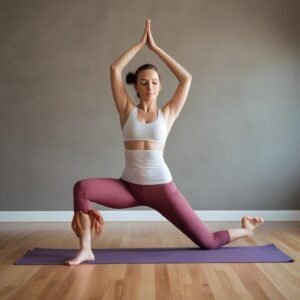What is the Genuine Objective of Yoga?
Presentation: Figuring out Yoga Past the Stances
Yoga, frequently saw only as a progression of actual activities, has a rich and significant history that stretches back millennia. Beginning in old India, yoga is a comprehensive practice that envelops physical, mental, and profound aspects. “Yoga” itself is gotten from the Sanskrit root “yuj,” and that means to burden or join together, representing the association of the body, brain, and soul.
While contemporary yoga rehearses in the West frequently underscore asanas, or actual stances, this addresses just a small part of what yoga genuinely envelops. All things considered, yoga was created as an extensive framework for accomplishing in general prosperity and otherworldly illumination. The old yogic texts, for example, the Yoga Sutras of Patanjali and the Bhagavad Gita, frame a complex way to deal with life that incorporates moral rules (yamas and niyamas), breath control (pranayama), contemplation (dhyana), and different practices intended to develop mindfulness and internal harmony.
In current times, yoga has acquired enormous ubiquity as a wellness system, frequently showcased for its actual advantages like adaptability, strength, and unwinding. Notwithstanding, this restricted viewpoint can eclipse the more profound goals of yoga. A genuine expert of yoga looks for actual wellbeing, yet in addition mental clearness, profound soundness, and otherworldly development. Thusly, yoga is an excursion of self-disclosure and self-change, meaning to orchestrate the person’s internal world with the external climate.
Normal misguided judgments about yoga being exclusively an active work can cheapen its more extensive reason. The pith of yoga lies in its capacity to encourage a reasonable and amicable life, rising above past the actual domain to contact the spirit. By getting it and embracing the full range of yoga’s lessons, one can open its actual potential and experience significant self-improvement.
The Actual Viewpoint: Developing Fortitude, Adaptability, and Wellbeing
The actual advantages of rehearsing yoga are complex, enveloping upgrades in strength, adaptability, equilibrium, and in general actual wellbeing. In the domain of solidarity, yoga supports the advancement of both strong and skeletal strength. Postures like the board, champion series, and different arm adjusts draw in numerous muscle gatherings, encouraging muscle development as well as improving joint dependability and bone thickness. This complete fortifying adds to all the more likely stance and diminished chance of injury.
Adaptability, one more foundation of yoga, is developed through a reliable act of represents that stretch and extend muscles. Positions like the forward overlay, descending canine, and different hip openers increment the scope of movement in joints, easing firmness and further developing versatility. Upgraded adaptability likewise supports the counteraction of muscle strains and joint torment, empowering a more liquid and lithe body.
Balance is a basic part of actual wellbeing that yoga essentially gets to the next level. Adjusting presents, for example, the tree present and the falcon present, challenge the body’s balance, upgrading proprioception and coordination. Further developed balance upholds proactive tasks as well as adds to fall avoidance, particularly in more seasoned grown-ups.
Past these actual traits, the act of yoga advances generally prosperity. Normal commitment to yoga can prompt superior cardiovascular wellbeing, expanded lung limit, and better absorption. The consolidation of breath control strategies, known as pranayama, assumes a fundamental part in enhancing these advantages. Pranayama rehearses, for example, substitute nostril breathing and ujjayi breath, upgrade oxygenation of the body, diminish feelings of anxiety, and backing respiratory wellbeing.
At last, the actual act of yoga fills in as a basic perspective that readies the body for more profound, more contemplative practices. By developing fortitude, upgrading adaptability, further developing equilibrium, and cultivating generally wellbeing, yoga outfits people with the actual flexibility important to investigate its more significant mental and profound dimensions.”’html
The Psychological and Profound Angle: Accomplishing Internal Harmony and Care
Yoga is broadly perceived for its significant effect on mental and close to home prosperity. One of the essential advantages of yoga is its capacity to decrease pressure, uneasiness, and sorrow. Through the joining of actual stances (asanas), breathing activities (pranayama), and reflection, experts can accomplish a condition of internal harmony and mental lucidity. This comprehensive methodology helps balance the brain and body, cultivating a feeling of serenity and profound dependability.
Contemplation and care are essential parts of yoga that altogether add to emotional wellness. Care, the act of being completely present at the time, assists people with turning out to be more mindful of their viewpoints and sentiments without judgment. This increased mindfulness permits specialists to oversee pressure all the more really and develop a quiet and centered mind. Contemplation, then again, includes focusing the psyche on a specific item, thought, or movement to accomplish an intellectually clear and genuinely quiet state. Standard reflection practice has been displayed to decrease side effects of nervousness and gloom, advancing by and large mental prosperity.
The idea of ‘yoga as an excursion’ underlines progressing mindfulness and self-improvement. Dissimilar to other wellness schedules that attention exclusively on actual accomplishments, yoga urges specialists to investigate their internal identities. This excursion includes pondering one’s contemplations, ways of behaving, and feelings, prompting more noteworthy self-understanding and self-awareness. By rehearsing yoga reliably, people can uncover further layers of their cognizance, cultivating a feeling of internal harmony and satisfaction.
Notwithstanding its psychological well-being benefits, yoga likewise improves profound versatility. The training trains people to stay cool and made in the face out of life’s difficulties, assisting them explore tough spots with effortlessness and balance. This close to home versatility is essential for keeping up with emotional well-being and prosperity in the present high speed and frequently unpleasant world.
The Profound Angle: Association with Oneself and the Universe
Yoga, past its actual postures and breath control, holds a significant otherworldly aspect that plans to accomplish ‘association’ or ‘unity.’ This association isn’t simply about the mixture of brain, body, and soul, yet additionally about adjusting oneself amicably with the universe. The term ‘yoga’ itself gets from the Sanskrit word ‘yuj,’ and that means to burden or tie, implying a definitive objective of this old practice: profound edification and self-acknowledgment.
Vital to this profound excursion are the eight appendages of yoga as depicted by the sage Patanjali in the Yoga Sutras. These eight appendages act as an extensive aide for moral and profound turn of events, driving professionals toward a definitive objective of samadhi, or otherworldly freedom. The initial two appendages, Yama and Niyama, center around moral and moral rules, for example, peacefulness, honesty, and self-control. These standards establish the groundwork for an amicable life, both with oneself and with others.
The resulting appendages, Asana and Pranayama, include actual stances and breath control, separately. While these are many times the most noticeable parts of yoga, they set up the body and psyche for more profound otherworldly practices. Pratyahara, the fifth appendage, includes withdrawal of the faculties, empowering specialists to turn internal and center around their inward world.
Dharana, Dhyana, and Samadhi, the last three appendages, are continuously more profound phases of focus, contemplation, and eventually, otherworldly edification. Dharana includes zeroed in focus on a solitary point, while Dhyana is the act of continuous reflection. Samadhi addresses the perfection of these endeavors, where the singular self converges with the all inclusive cognizance, accomplishing a condition of unity and significant harmony.
Generally, yoga’s otherworldly objectives expect to rise above the physical and mental domains, directing experts toward mindfulness and widespread congruity. By incorporating these standards into day to day existence, yoga cultivates a decent, satisfying presence, improving the individual, yet additionally their general surroundings.


